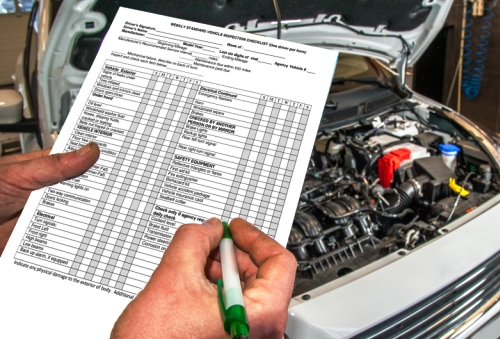
Are comebacks just coincidences, or do we sometimes miss diagnostic clues that should have been obvious to us as experienced technicians, if not to service writers? This is an important point, because one major aspect of how we diagnose faults involves blurred lines of responsibility: service writers are not always mechanics, and as mechanics, we do not always have the opportunity to speak to customers directly about a particular concern or problem they might experience. In this article then, we will discuss pre-diagnostic routines as a means to avoid missing important diagnostic clues, which will go a long way towards preventing embarrassing comebacks, starting with this question-
All experienced technicians understand why OEM diagnostic trees / flow-charts are designed the way they are, and we generally follow their prescripts very closely. However, inexperienced mechanics may not always be aware of, or understand the importance of a thorough visual inspection of a suspected defective system/part/component before plugging in a scan tool, which should ideally be one of the last steps in a well-structured diagnostic process.
As a practical matter, the overall condition and appearance of a vehicle is a valuable diagnostic tool in itself, since how a vehicle looks is often directly related to its overall condition and state of repair. For instance, lots of dings in the bodywork, scratches in the paint, and a dirty interior are good indicators of the owner’s attitude towards his vehicle. If dings, scratches, and dirty upholstery do not matter, then regular servicing and maintenance almost certainly do not matter, too.
Moreover, owners of poorly maintained vehicles are very often poor sources of information about the issues they experience. Interviewing such a vehicle owner often produces responses like “Don’t ask me, you’re the mechanic”, or “The noise started a while back- I’m not exactly sure when but it’s been a while and it has been getting worse as of late”- which are statements that have no diagnostic value whatsoever.
Conversely, owners of well-maintained vehicles are almost invariably good sources of information. They generally know when the problem started, what the symptoms are they experience or observe, under what conditions the symptoms appear, and how the symptoms affect driveability, fuel economy, vehicle stability, etc.
However, as we all know, since service writers are not always mechanics, they often do not know what questions to ask, or what to look or listen for when they test-drive a vehicle. In these cases, we do not always have all the information we need to make a definitive diagnosis, and it is here where a well thought-out pre-diagnostic routine can save you a lot of time and trouble, which begs this question-

In simple terms, a pre-diagnostic routine can be described as a process in which you inspect the relevant defective system, subsystem, part, component, or sometimes the entire vehicle to gather as much background information about the possible causes of a particular customer concern as you can. The alternative is to plug a scan tool into the vehicle to extract fault codes, which as we know, sometimes tells us nothing.
For instance, say you are presented with a petrol-engine vehicle with a random misfire code, which as we know, can have myriad causes. However, while a quick inspection of the engine compartment may not always reveal the root cause of the code, the overall appearance of the engine and associated wiring, hoses and vacuum lines can narrow the possibilities down considerably.
If for example, the engine is dirty and caked with dust that clings to long-time oil and other fluid leaks, it is almost certain that it has not been serviced in a long while. Therefore, dead and/or dying spark plugs, clogged or dirty injectors and/or filters, or corroded electrical connectors become prime suspects as the most likely cause(s) of the misfire.
However, while the above scenario is a good case in point, misfires also occur on clean, well-maintained vehicles, and it is in these cases that a good pre-diagnostic routine can be a particularly valuable diagnostic aid. Let us again use misfires as an example-
While it would be easy to plug in a scan tool and identify the misfiring cylinder(s), the scan tool may not identify the root cause(s) of the misfire. Thus, in the absence of additional codes and/or information about the issue from the customer, we need to use our senses (including our common sense), to confirm, or eliminate some common causes of misfires as the most likely root cause of the issue.
In order to do this, we can perform a pre-diagnostic routine that is tailored to identify the most likely cause(s) of misfires on petrol engines. As a practical matter, a tailored pre-diagnostic routine to identify the most likely cause of random misfires would typically involve using our senses to answer the following questions-
Smell
Sight
Touch
Hearing
NOTE: This list of questions is neither complete, nor exhaustive, and while it is intended for general informational purposes only, it should serve to illustrate the point that a good pre-diagnostic routine should address all possible causes of a problem or customer concern.
Common sense
Common sense now becomes the most valuable of our senses, since the answers to some of the questions above will eliminate some causes of the misfire, while others will warrant further investigation, and the problem now becomes one of deciding what to investigate first, and how far to take the investigation.
We may have confirmation from a scan tool that a misfire exists, but in this case, the misfire is merely a symptom that has little to no diagnostic value. Thus, depending on the answers to one or more of the above questions, an inexperienced mechanic might be tempted either to jump to premature conclusions, or to draw inferences that may not be valid, since the pre-diagnostic routine is not yet complete.
At this point, common sense dictates that a compression and/or cylinder leak down test be performed, and that the results be tested against the answers to the above questions. Moreover, common sense also dictates that before we can draw valid inferences about the most likely cause(s) of the misfire, we also need to interrogate all the ECU’s on the vehicle to extract all active and pending codes in order to confirm or eliminate for instance, ignition and/or fuel system-related causes of the misfire.
In the interest of fairness to inexperienced mechanics though, it must be stated that while there is a direct correlation between common sense and experience, your level of experience largely dictates what does, or does not make sense to you when you are diagnosing tricky issues.
Nonetheless, it is also true that while no mechanic or technician can be effective without the use of high-tech diagnostic equipment today, this writer has observed many young and inexperienced mechanics develop an over reliance on [diagnostic] gadgets. This often results in them missing, or worse, ignoring important visual and/or auditory clues to the most likely cause(s) of a customer concern, which brings us to-
Up to this point, this article may have created the impression that pre-diagnostic routines are the be-all and end-all of automotive diagnostics, which is not the case. The fact is that to be effective in diagnosing issues, you need to follow the three-legged stool principle, which states that all three legs of the stool must be present for the stool to be stable. In practice, a well-structured pre-diagnostic routine represents one leg of the stool, while practical experience and a sound theoretical knowledge of automotive design and control/management systems represent the other two legs, respectively.
Taking the analogy a bit further, one can say that the seat of the stool represents scan tool and/or oscilloscope data that can sometimes only be interpreted correctly once the observed symptoms of the customer concern are reconciled with the answers obtained during the pre-diagnostic phase. Put in another way, all three legs of the stool must be present, and of the same length for the seat to be stable, i.e., for the scan tool data to make sense.
While the importance of performing pre-diagnostic checks can hardly be over stated, the fact is that both experience and theoretical knowledge determine the quality and/or relevance of the pre-diagnostic routine. For instance, a mechanic that does not have much experience with, or knowledge of say, DPF regeneration technologies and strategies, will not be in a position to develop a relevant pre-diagnostic routine for this issue, since his lack of theoretical knowledge prevents him from asking the right questions.
For instance, one such question may be “Is the current no-start condition related to the DPF regeneration issue, and if so, what is the causal relationship between the no-start condition and the DPF regeneration issue?” As it turns out, several DPF related issues could cause no-start conditions and cause them to persist until the fault is corrected. However, since an inexperienced mechanic may not fully understand DPF regeneration and/or what happens (or could happen) when DPF regeneration does not occur or does not run to completion, he might be tempted to rely solely on scan tool data, which won’t tell him much, if anything.
In this type of situation, a simple pre-diagnostic routine that is based on a sound theoretical knowledge and experience of DPF regeneration issues will include an inspection of the entire reductant injection system, including checking for evidence of damage to the DPF and other components of the exhaust system. In practice, such an inspection will result in a definitive diagnosis much sooner than would have been the case had an inexperienced mechanic worked through the usual list of probable causes of fault codes that come with fault code definitions.

The image above shows the kind of situation we all hope never happens to us: an irate customer demanding to know why the problem that he had brought his car in for a week ago is back. In most comebacks, the nature and cause(s) of the original problem is not relevant, but what is always relevant, is the fact that a logical and well-structured pre-diagnostic routine would almost certainly have revealed say, an incipient ignition coil failure, or perhaps a leaking brake caliper, or that the transmission fluid should have been replaced a long time ago.
Had the relevant clues been detected during the original pre-diagnostic process, the technician in the above picture would not have had to explain why the original problem was not fixed the first time around. Essentially, pre-diagnostic routines can be developed for almost any problem on any vehicle and when such routines are applied in a logical manner, they almost invariably address all the probable causes of an issue, regardless of the system or subsystem that is affected.
Nonetheless, it should be borne in mind that while no pre-diagnostic routine can ever replace scan tool data, applying the three-legged stool approach to your diagnostic procedures will let you diagnose even complex issues faster, and more accurately the first time.